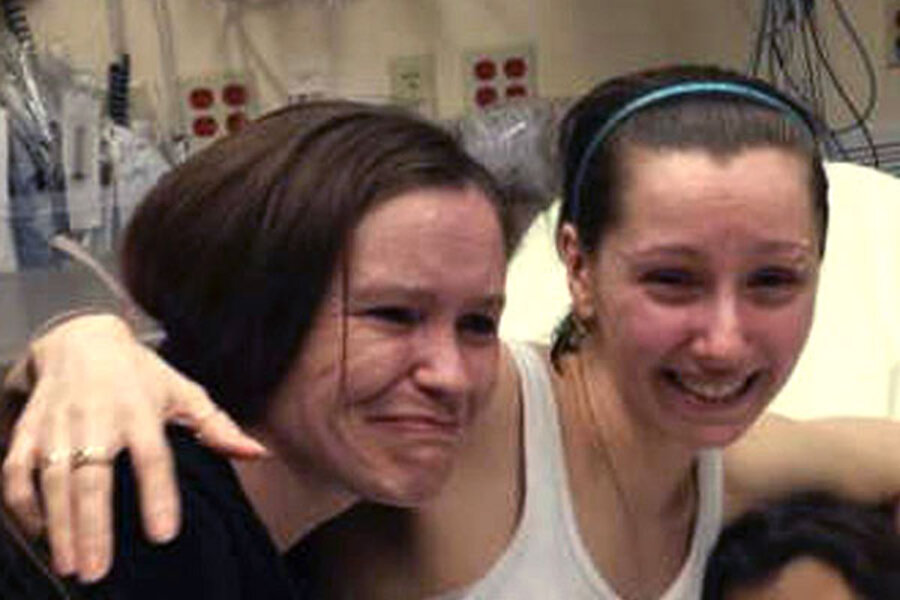For Amanda Berry and other Cleveland victims, recovery begins with patience
Loading...
After a decade of being held captive in a Cleveland home, three women freed Monday night face a healing process that will not be easy or happen overnight, say experts.
In 10 years, the world has changed, and they have changed. The youngest captive, Gina DeJesus, was kidnapped at age 14. The mother of another of the captives, Amanda Berry, died three years after she was abducted, and reports suggest that a 6-year-old girl freed from the house Monday could be Ms. Berry’s daughter.
For women who have had little control of their own lives for years, the transition back into a normal life can be overwhelming, and the struggle to regain a sense of control often begins with the need to tell their own story in their own time and on their own terms. The seeds of recovery, experts add, often bloom only with time and no small amount of love.
“It’s going to take a lot of understanding and patience from friends and family to try to help them lead the life they want to,” says Jim Hmurovich, president of Prevent Child Abuse America, an advocacy group in Chicago.
Systematic abuse at the hands of a stranger, particularly when it takes place during a long period of confinement, can create in victims intense feelings of hopelessness and worthlessness. Recovery can often be affected by how victims deal with these raw emotions.
“Being held and traumatized for a long time, you often develop questions like, ‘Why me?’ or ‘Will this ever end?’ and will try to determine the meaning of the trauma,” says Megan Berthold, a clinical social worker at the National Association of Social Workers, who has worked with refugee survivors of torture. “Often you don’t know if you will survive, so being able to make some sense out of it, and developing strategies to cope, to be resilient in the process, can make a huge difference on whether one survives the ordeal, and in shaping their response afterward.”
Elizabeth Smart, the Salt Lake City girl freed in 2003 after nine months in captivity, says tormentors use sexual violence to devalue the victim’s individual worth, making them feel they have to remain under their captor’s protection. Speaking at a human trafficking forum at Johns Hopkins University in Baltimore last week, Ms. Smart said her captor reduced her to feeling like “a chewed up piece of gum.
“Nobody re-chews a piece of gum, you throw it away. And that’s how easy it is to feel like you no longer have worth, you no longer have value. Why would it even be worth screaming out? … Your life still has no value,” said Smart, who is now an advocate for victims of sexual violence.
The possibility that at least one of the Cleveland women had a child during her captivity could add new and complicated dimensions to her recovery. The situation appears to echo that of Jaycee Dugard, who was kidnapped in 1991 at age 11 and held in captivity for 18 years in Antioch, Calif., during which time she gave birth to two children.
When victims are raped and conceive children, “the child may serve as a possible reminder of the perpetrator, trigger memories of him, and of those experiences,” says Ms. Berthold.
Yet children can also help victims cope, she adds. “The child may have bonded in a very positive way with the mother in giving them her a sense of purpose to stay alive.”
The fact that the women were so young when they were kidnapped – Ms. DeJesus at age 14, Berry at 16, and Michelle Knight at 20 – also means they will return as adults to lives they were taken from as children. These will be new lives that the women might not recognize. “This kind of upheaval may be hardest to cope with,” says Victor Vieth, director of the National Child Protection Training Center in St. Paul, Minn. “You become a person frozen in time. How do you get that time back?”
Berry’s mother died in 2006 after three years looking for her daughter. “She literally died of a broken heart,” family friend Dona Brady told the Associated Press.
During this process, reuniting with former loved ones can become traumatic if family members or friends push too hard to learn the details about the victim’s experience while in captivity. Recovery can take years, and victims need time to feel that they control their own story, which is a first step to feeling empowerment over their own lives, says Katie Hanna, executive director of the Ohio Alliance to End Sexual Violence in Cleveland.
“It gives them some of that power back when so much power was taken away from them,” Ms. Hanna says.
Often, victims of sexual violence feel most comfortable talking to other victims.
“It is often difficult for survivors to talk about what happened because of the social stigma of what happened. Individual therapy can help, but sometimes connecting with other survivors can be very validating for them,” Hanna says.
Ms. Dugard told ABC News in March 2012 that a breakthrough in her recovery was realizing she had the power to make decisions on her own, after almost two decades of conceding that authority to her captors.
“Just being free to do what I want to do, when I want to do it,” she said. “That's the whole learning process to, to know that you can.”








